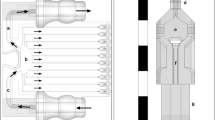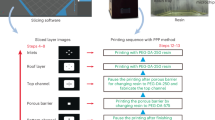Abstract
The majority of microfluidic devices used for cell culture, including Organ-on-a-Chips (Organ Chips), are fabricated using polydimethylsiloxane (PDMS) polymer because it is flexible, optically clear, and easy to mold. However, PDMS possesses significant challenges for high volume manufacturing and its tendency to absorb small hydrophobic compounds limits its usefulness as a material in devices used for drug evaluation studies. Here, we demonstrate that a subset of optically clear, elastomeric, styrenic block copolymers based on styrene-ethylene-butylene-styrene exhibit reduced absorption of small hydrophobic molecules and drug compounds compared to PDMS and that they can be fabricated into microfluidic devices with fine features and the flexibility required for Organ Chips using mass production techniques of injection molding and extrusion.




Similar content being viewed by others
References
Bhatia SN, Ingber DE (2014) Microfluidic organs-on-chips. Nat Biotechnol 32:760–772. doi:10.1038/nbt.2989
Boonchareon W, Apisittinet S, Sirikittikul D, Loykulnant S, Fuougfuchat A, Ritvirulh C, Sooknoi T (2007) Structure and Gas Selectivity of PE/Zeolite composite film. In: The 2nd international conference on advanced in petrochemicals and polymers (ICAPP 2007), Bangkok
Borysiak MD, Bielawski K, Sniadecki NJ, Jenkel CF, Vogt BD, Posner JD (2013) Simple replica micromolding of biocompatible styrenic elastomers. Lab Chip 13:2773–2784. doi:10.1039/C3LC50426C
Brassar D, Clime L, Li K, Geissler M, Miville-Godin C, Roy E, Veres T (2011) 3D thermoplastic elastomer microfluidic devices for biological probe immobilization. Lab Chip 11:4099–4107. doi:10.1039/c1lc20714h
Domansky K et al (2013) Clear castable polyurethane elastomer for fabrication of microfluidic devices. Lab Chip 13:3956–3964. doi:10.1039/c3lc50558h
Drobny JG (2014) Handbook of thermoplastic elastomers. In: Plastics design library, 2nd edn. Elsevier, Amsterdam, Netherlands
Fang L, Wei M, Shang Y, Jimenez L, Kazmer D, Barry C, Mead J (2009) Surface morphology alignment of block copolymers induced by injection molding. Polymer 50:5837–5845. doi:10.1016/j.polymer.2009.09.013
Guillemette MD, Roy E, Auger FA, Veres T (2011) Rapid isothermal substrate microfabrication of a biocompatible thermoplastic elastomer for cellular contact guidance. Acta Biomater 7:2492–2498. doi:10.1016/j.actbio.2011.02.019
Heo YS, Cabrera LM, Song JW, Futai N, Tung Y-C, Smith GD, Takayama S (2007) Characterization and resolution of evaporation-mediated osmolality shifts that constrain microfluidic cell culture in poly(dimethylsiloxane) devices. Anal Chem 79:1126–1134. doi:10.1021/ac061990v
Houston KS, Weinkauf DH, Stewart FF (2002) Gas transport characteristics of plasma treated poly (dimethylsiloxane) and polyphosphazene membrane materials. J Membr Sci 205:103–112. doi:10.1016/s0376-7388(02)00068-6
Huh D, Matthews BD, Mammoto A, Montoya-Zavala M, Hsin HY, Ingber DE (2010) Reconstituting organ-level lung functions on a chip. Science 328:1662–1668. doi:10.1126/science.1188302
Huh D et al (2013) Microfabrication of human organs-on-chips. Nat Protoc 8:2135–2157
Kang D, Matsuki S, Tai Y-C (2015) Study of the hybrid parylene/PDMS material. In: 28th IEEE international conference on micro electro mechanical systems (MEMS 2015), Estoril, Portugal, IEEE, pp 397–400
Keller A, Pedemont E, Willmout Fm (1970) Macro-lattice from segregated amorphous phases of a 3 block copolymer. Nature 225:538. doi:10.1038/225538a0
Kim HJ, Huh D, Hamilton G, Ingber DE (2012) Human gut-on-a-chip inhabited by microbial flora that experiences peristalsis-like motions and flow. Lab Chip 12:2165–2174. doi:10.1039/c2lc40074j
Kim M, Lam RHW, Thorsen T, Asada HH (2013) Mathematical analysis of oxygen transfer through polydimethylsiloxane membrane between double layers of cell culture channel and gas chamber in microfluidic oxygenator. Microfluid Nanofluid 15:285–296. doi:10.1007/s10404-013-1142-8
Lamberti A, Marasso SL, Cocuzza M (2014) PDMS membranes with tunable gas permeability for microfluidic applications. Rsc Adv 4:61415–61419. doi:10.1039/c4ra12934b
Lee HH, Register RA, Hajduk DA, Gruner SM (1996) Orientation of triblock copolymers in planar extension. Polym Eng Sci 36:1414–1424. doi:10.1002/pen.10536
Merkel TC, Bondar VI, Nagai K, Freeman BD, Pinnau I (2000) Gas sorption, diffusion, and permeation in poly(dimethylsiloxane). J Polym Sci Part B: Polym Phys 38:415–434
Monprasit P, Ritvirulh C, Sooknoi T, Rukchonlatee S, Fuongfuchat A, Sirikittikul D (2011) Selective ethylene-permeable zeolite composite Double-layered film for novel modified atmosphere packaging. Polym Eng Sci 51:1264–1272. doi:10.1002/pen.21924
Panaitescu DM, Gabor RA, Nicolae CA, Ghiurea M, Mihailescu M, Grigorescu RM (2014) Influence of melt processing induced orientation on the morphology and mechanical properties of poly(styrene-b-ethylene/butylene-b-styrene) block copolymers and their composites with graphite. Mater Des 64:694–705. doi:10.1016/j.matdes.2014.08.049
Park J, Na S, Kang M, Sim S, Jeon N (2017) PDMS microchannel surface modification with Teflon for algal lipid research BioChip published online 03 March 2017, DOI: 10.1007/s13206-017-1302-0
Regehr KJ et al (2009) Biological implications of polydimethylsiloxane-based microfluidic cell culture. Lab Chip 9:2132–2139. doi:10.1039/b903043c
Robb WL (1968) Thin silicone membranes–their permeation properties and some applications. Ann N Y Acad Sci 146:119–137. doi:10.1111/j.1749-6632.1968.tb20277.x
Roy E, Galas J-C, Veres T (2011a) Thermoplastic elastomers for microfluidics: towards a high-throughput fabrication method of multilayered microfluidic devices. Lab Chip 11:3193–3196. doi:10.1039/c1lc20251k
Roy E, Geissler M, Galas J-C, Veres T (2011b) Prototyping of microfluidic systems using a commercial thermoplastic elastomer. Microfluid Nanofluidics 11:235–244. doi:10.1007/s10404-011-0789-2
Sakurai S (2008) Progress in control of microdomain orientation in block copolymers—efficiencies of various external fields. Polymer 49:2781–2796. doi:10.1016/j.polymer.2008.03.020
Sasaki H, Onoe H, Takeuchi S (2010) Parylene-coating in PDMS microfluidic channels prevents the absorption of fluorescent dyes Sensors and Actuators B. Chemical 150:478–482
Shirure V, George S (2017) Design considerations to minimize the impact of drug absorption in polymer-based organ-on-a-chip platforms. Lab Chip 17:681–690. doi:10.1039/C6LC01401A
Sipkens K (2000) SEBS-based compounds. Med Device Technol 11:8–13
Sudarsan AP, Wang J, Ugaz VM (2004) Novel thermoplastic elastomers for microfluidic device construction. In: Laurell T, Nilsson J, Jensen K, Harrison DJ, Kutter JP (eds) 8th international conference on miniaturized systems for chemictry and life science (MicroTAS). The Royal Society of Chemistry, Malmo, pp 22–24
Sudarsan AP, Wang J, Ugaz VM (2005) Microfabrication of 3D structures using novel thermoplastic elastomers. In: NSTI nanotechnology conference and trade show, Anaheim pp 523–525
Sudarsan AP, Wang J, Ugaz VM (2005b) Thermoplastic elastomer gels: an advanced substrate for microfluidic chemical analysis systems. Anal Chem 77:5167–5173. doi:10.1021/ac050448o
Toepke MW, Beebe DJ (2006) PDMS absorption of small molecules and consequences in microfluidic applications. Lab Chip 6:1484–1486. doi:10.1039/b612140c
van Meer B et al (2017) Small molecule absorption by PDMS in the context of drug response bioassays. Biochem Biophys Res Commun 482:323–328. doi:10.1016/j.bbrc.2016.11.062
Acknowledgements
This work was supported by the Defense Advanced Research Projects Agency (DARPA) under Cooperative Agreement Number W911NF-12-2-0036. The content of the information does not necessarily reflect the position or the policy of DARPA or the US Government, and no official endorsement should be inferred. We also thank the Organ Chips teams at both the Wyss Institute and Emulate Inc. for their input.
Author information
Authors and Affiliations
Contributions
K.D. designed and executed most of the experiments under the supervision of D.E.I., with the exception of the quantitative compound loss study in Table 1, which was done at Emulate Inc. by J.D.S. with input from G.A.H. and D.L.; J.P.F. and T.H.I. provided technical assistance in the cell culture studies; N.W. performed the optical transmittance characterization; K.D., C.H., and G.T. contributed to the design and development of the 3-layer microfluidic and the SEBS prototype manufacturing methods; K.D. and D.E.I. prepared the manuscript with input from other co-authors.
Corresponding author
Ethics declarations
Conflict of interest
D.E.I. holds equity in Emulate, Inc. and chairs its scientific advisory board. G.A.H., D.L., J.D.S., N.W., C.H., and G.T. are all currently employees of Emulate Inc.
Additional information
Karel Domansky and Josiah D. Sliz are joint first authors.
Electronic supplementary material
Below is the link to the electronic supplementary material.
Rights and permissions
About this article
Cite this article
Domansky, K., Sliz, J.D., Wen, N. et al. SEBS elastomers for fabrication of microfluidic devices with reduced drug absorption by injection molding and extrusion. Microfluid Nanofluid 21, 107 (2017). https://doi.org/10.1007/s10404-017-1941-4
Received:
Accepted:
Published:
DOI: https://doi.org/10.1007/s10404-017-1941-4




